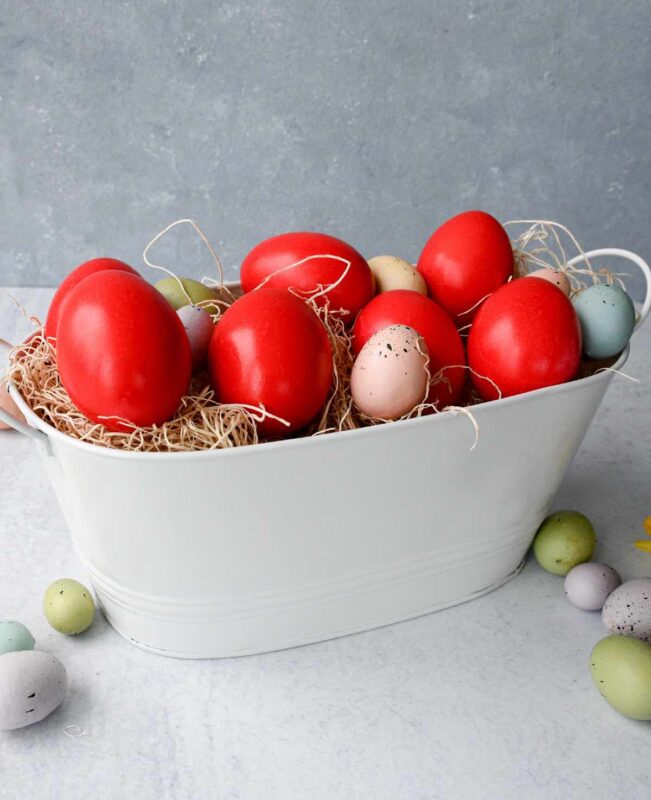The Tradition of Greek Red Easter Eggs
Eggs are dyed on Holy Thursday and saved for Easter Sunday, but you can dye them at any point before Easter Sunday. The colour red signifies the blood of Christ, and the egg symbolizes rebirth and new life.
My favourite part of Greek Easter, or as my Canadian friends would say, “Greekster,” are the outdoor gatherings with friends and family. There is almost delicious homemade food like lamb on a spit, spanakopita, greek potatoes (of course!), tzatziki, salads, cheese pie, tsoureki, and koulourakia.
Tsougrisma (Greek Egg-Cracking Game)
The egg-cracking game, called tsougrisma, is played between two people and two eggs. One person holds the egg from the bottom, and the other person holds the egg from the top. The person holding the egg from above hits the opponent’s egg (the bottom egg). Then it is reversed using the sides of the eggs that haven’t cracked yet. The person whose egg doesn’t break is said to have good luck for the rest of the year!
RECIPE TIPS
- Use room-temperature fresh brown eggs to help prevent the eggs from cracking when boiling (remove them from the fridge a couple of hours before you use them). I found using brown eggs instead of white eggs produced the best results.
- When boiling the eggs, they should be in a single layer and not on top of each other.
- White vinegar helps the colour of the red eggs become more vibrant colour however, you want to be careful with the amount of vinegar because too much vinegar will cause the eggs to become speckled.
- You may want to use disposable gloves while you dye the eggs to prevent the dye from going on your hands.
- I use red food colouring dye from the baking aisle in the grocery store. You could also use red dye packets from Greek or Mediterranean specialty stores. From my research, you may get better results by using less vinegar than the packet suggests to reduce the unappealing speckled texture of the dyed eggs.
- I’d recommend not using any porous materials (plastic, wood, ceramic etc.), and if you do get stains on your countertops, cover any stains with dish soap right away. Let it sit for a couple of minutes, and then wipe it away with a wet cloth.

HOW TO DYE RED GREEK EASTER EGGS: STEP BY STEP
STEP 1: Boil the eggs. In a medium-sized deep pot, add cold water (about 5 cups of water) and then carefully place a dozen (12) brown eggs in a single layer. Place eggs in a single layer at the bottom of a pot. Water should be 1 inch above the top of the eggs.
Bring the water to a boil on medium heat, then cover it with a lid and reduce the heat to low. Boil the eggs for 15 minutes. Place a strainer in the sink. Use a slotted spoon to carefully and gently place all of the eggs in the strainer. Rinse with cold water for a minute or so until the eggs have cooled to stop the cooking process.
STEP 2: Prepare the food colouring. Transfer the warm water to a large glass or stainless steel bowl. Add in 36 ml (.27 fl oz) red food colouring dye (2 small bottles). Add 2 tablespoons of vinegar. Mix together and then carefully place the cooked eggs in the food colouring for at least 15 minutes. The eggs should be fully submerged. You can stir occasionally, careful not to crack the eggs. The longer the eggs stay in the food colouring, the deeper red they will be.
STEP 3: Dry the eggs. Place a paper towel on a large plate. Use a slotted spoon to remove the eggs and place them on the paper towel to dry for at least 30 minutes. Once they’re dry, pour a little bit of olive oil or vegetable oil on a paper towel or soft cloth and rub the eggs to create a beautiful shine.
STEP 4: Christos anesti! Refrigerate the dyed eggs in an egg container until you’re ready to use them. The dyed eggs can also be placed in traditional Easter bread (Tsoureki) or stored in the fridge for up to seven days.
Greek red Easter eggs are usually dyed on Holy Thursday and saved for a feast on Easter Sunday. But you can dye them at any point before Easter Sunday. The colour red signifies the blood of Christ, and the egg symbolizes rebirth and new life.
You should start with cold water and room-temperature eggs. Placing cold eggs in hot water may cause them to crack
This stops the cooking process and reduces the iron-sulphur reaction, which can lead to a green yolk.
More Greek Easter Recipes!
Date Published: April 11, 2023

Hi I actually have a question. I know your recipe says eggs can be either white or brown, but do you have a preference? When we die them at church it seems one is better than the other and I cannot recall which one that is from last year. Thank you!
Hi Barb,
My family uses brown eggs, but it can be either. Just make sure that the eggs are room temperature before boiling.
Great to hear from you!
Ria
Thank you for this recipe. However, I followed your instructions exactly like you said, even leaving the eggs in the die for almost 2 hours. All I ended up with were bright pink eggs. Any advice?
Hi Lisa, thank you so much for giving my recipe a try and I’m sorry that the eggs did not turn out as you hoped. I just re tested the recipe with brown eggs and removed leaving the eggs in the dye for 2 hours which seemed to work better. Wishing you a wonderful Easter!
All the best,
Ria